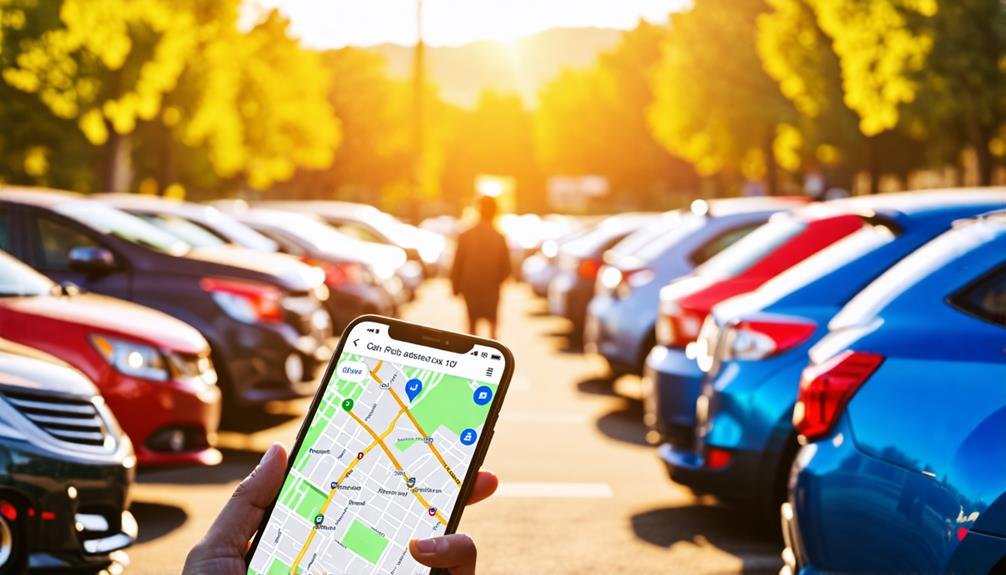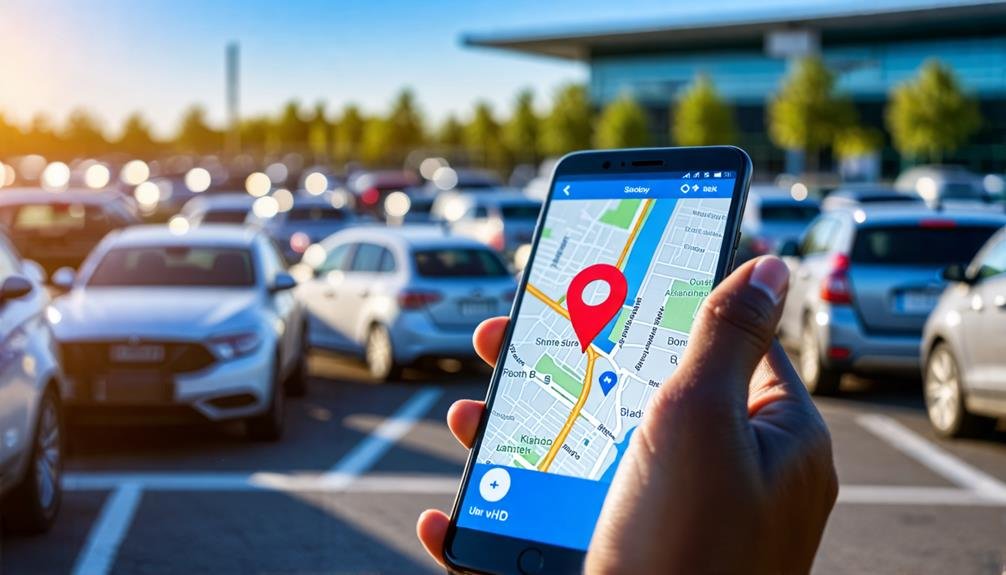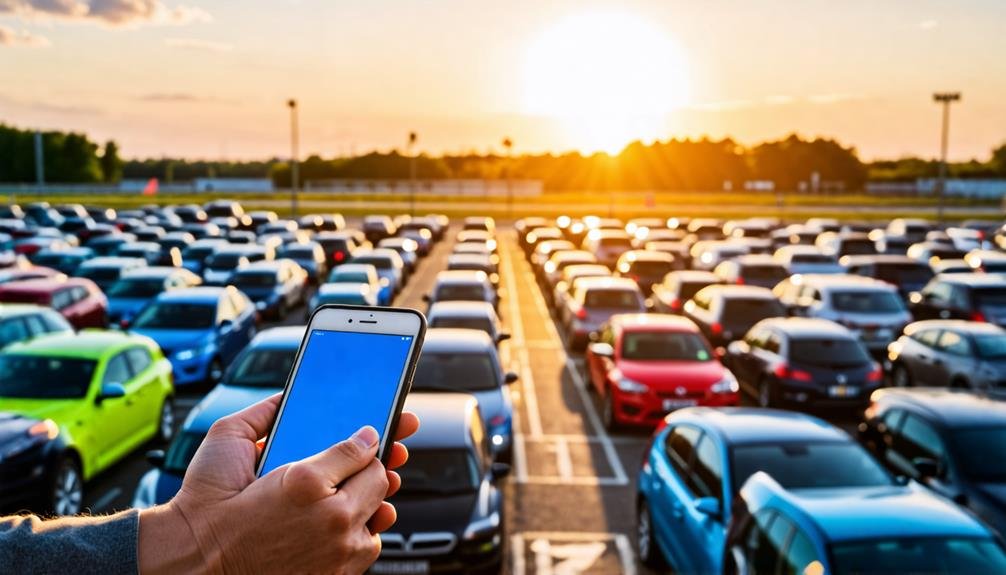To avoid losing your car in a crowded airport parking lot, utilize a science-backed hack that boosts your key fob's signal. By holding the remote near your head, the body's high water content acts as a dielectric resonator, amplifying the signal. This technique transforms your key fob into a mini-antenna, expanding its range. Research shows this approach facilitates vehicle location, even amidst interference, making it an effective and cost-efficient alternative to expensive tracking devices. Additionally, simple strategies like using mobile apps can improve your parking experience, ensuring you never lose track of your car again. Explore additional insights on practical solutions ahead.
Understanding Signal Enhancement
Understanding how human bodies can enhance radio signals from car key fobs is essential for effectively finding vehicles in busy parking lots. Human bodies, made up of around 60% water, serve as natural amplifiers for radio signals. When a user holds a key fob near their head, the water within interacts with radio frequency waves, forming a dielectric resonator that boosts signal transmission. This effect enables cars to respond from a longer distance, which is especially helpful in scenarios like airport parking, where spotting your car can be difficult.
Additionally, this method is entirely safe; the radio signals from car key fobs are low and do not present health hazards. Interestingly, placing the remote against a water bottle can produce similar effects, providing an alternative approach for those interested in this key fob technique.
Integrating this knowledge into your travel strategies can significantly enhance your parking experience, ensuring you can easily find your vehicle even in densely packed areas. By grasping the science of signal enhancement, travelers can achieve greater control and convenience in their parking situations.
Testing the Remote Hack
Testing the Remote Hack
Practical experiments of the car remote-to-head hack show its effectiveness in real parking situations. The experiment, initially conducted in a busy shopping mall parking area, aimed to replicate challenges seen in crowded airport settings. Participants parked their cars and walked away, evaluating the remote signal from varying distances, typically spanning from 16 to 65 feet. Early attempts produced mixed outcomes, but when the remote was positioned close to the head, the vehicle responded successfully, unlocking the doors.
This technique leverages the human body's ability to amplify radio signals due to its high water content. While the tests illustrated the hack's potential, external factors such as vehicle type, signal interference from structures, or even the user's familiarity with the parking lot could influence results. Considering these variables helped create a realistic scenario, allowing for a comprehensive evaluation of the hack's effectiveness. Overall, the tests provide valuable insights into how this innovative method can assist individuals in locating their vehicles, especially in busy environments, offering a sense of autonomy and control amidst the disorder of crowded parking lots.
Effectiveness of the Hack

The effectiveness of the car remote-to-head technique is evident in its ability to extend the range of the remote signal, particularly in crowded parking lots where locating a car can be challenging. This technique leverages the body's water content, which acts as a dielectric resonator, enhancing the remote's signal transmission. When the remote is positioned near the head, it transforms into a mini-antenna, allowing for communication with the vehicle from distances beyond the normal ranges of 16 to 65 feet.
Tests have validated the dependability of this method, even amidst potential interference from surrounding signals and obstacles in busy parking areas. While initial attempts may yield inconsistent results, the repeated success of this technique in unlocking and finding vehicles demonstrates its practicality.
Factors such as the particular automobile brand and the distance to the vehicle can affect the overall effectiveness of the method. However, the straightforward and budget-friendly nature of this approach makes it appealing for individuals seeking autonomy in crowded environments. In conclusion, although not infallible, the car remote-to-head trick presents an intelligent solution for recovering lost vehicles.
Advantages of the Technique
The technique of using your head as a car remote antenna offers notable advantages, primarily in enhancing signal strength quickly. This method serves as a cost-effective solution, eliminating the need for expensive tracking devices while providing a reliable way to locate your vehicle. By harnessing the natural properties of the human body, this approach simplifies the process of finding your car in crowded parking environments.
Quick Signal Enhancement
Using the natural conductivity of the human body, especially its water content, can enhance the signals of car remotes like those from Ford or Toyota. The human body, which contains around 60% water, serves as a dielectric resonator, improving the travel of radio frequency waves from car remotes. When individuals hold the remote near their head, it acts as a small antenna, increasing the distance from which the vehicle can respond.
This approach offers several benefits:
- Extended Access: Unlock your Honda or Nissan from farther away, easing the challenge in busy parking areas.
- Ease of Use: This technique needs no extra devices, making it straightforward for everyday use.
Cost-Effective Solution
Using the car-remote-to-head technique provides a budget-friendly method for finding vehicles in busy parking lots, removing the necessity for expensive GPS trackers or services. This method takes advantage of the human body's natural characteristics, particularly its high water content, to enhance signal transmission from the car remote. By positioning the remote against your forehead, you transform it into a small antenna, increasing the distance from which your vehicle can respond.
This strategy not only cuts costs but also streamlines the task of locating your car after a lengthy trip or while navigating a crowded airport parking structure. Traditional tracking systems often involve monthly fees or upfront costs, while this method is entirely free, relying solely on what you already have on hand. Plus, it can be performed immediately, making it a practical choice for travelers seeking convenience without financial pressure.
Although the success of this technique may depend on variables such as distance and vehicle brand, its straightforwardness and accessibility render it a useful resource for anyone wishing to maintain their independence and efficiency while traveling. Ultimately, it empowers users to confidently and affordably navigate their surroundings.
Limitations to Consider

The car remote-to-head technique offers a helpful solution for finding vehicles in busy parking lots, yet several limitations should be considered. First, the effectiveness of this method can vary greatly depending on the specific circumstances. Factors like the brand and model of the automobile can affect how well the remote signal is received. Additionally, the distance from the vehicle plays a significant role, making it less dependable in larger parking areas.
- Signal Strength: The range at which the automobile responds may decrease if obstacles, such as walls or other cars, are present.
- Environmental Interference: Nearby electronic devices and competing radio frequencies can disrupt signal transmission, diminishing the effectiveness of this technique.
Recognizing these limitations allows you to make informed choices regarding this technique. While it can be a useful tool, success is not guaranteed; thus, pairing it with other strategies may lead to better outcomes in your search for your automobile.
Alternative Solutions Available
Given the challenges of the car remote-to-head technique, exploring alternative solutions can significantly enhance your ability to find your vehicle in busy parking areas. One effective option is using smartphone applications like Google Maps or Find My Car, which leverage GPS technology to accurately locate your vehicle. These apps are user-friendly and seamlessly integrate with your smartphone.
Another alternative is employing a dedicated GPS tracker, such as the Tile Mate for vehicles. These devices provide real-time location information, allowing you to effortlessly track your car. Additionally, remembering or jotting down your parking space can be a straightforward yet effective approach to minimize reliance on hacks.
Ride-sharing services like Uber or Lyft can also be a practical choice, especially for frequent travelers, as they eliminate the need to locate your own vehicle entirely. Lastly, seeking assistance from parking attendants can offer immediate support if you find yourself disoriented in a large airport lot. By considering these alternatives, you can enhance your parking experience and alleviate the stress of locating your car amidst the chaos of crowded environments.
Practical Tips for Parking

Effective parking tactics can significantly alleviate the stress of finding your car in crowded places. By adopting a few straightforward strategies, you can enhance your parking experience, ensuring a smoother journey.
- Select Your Location Carefully: Pick spaces close to entrances or exits to shorten walking distances and boost visibility. Whenever possible, choose spots marked by recognizable features like parking signs or light poles to help you remember where you parked.
- Leverage Mobile Applications: Use popular apps like Google Maps or ParkMe to pin your parking location. Many of these applications also offer navigation back to your vehicle, saving time and reducing frustration.
Real-Life Applications of the Hack
Integrating the car remote to head technique into your parking approach can significantly improve your ability to find your vehicle in crowded areas, enhancing practical strategies for efficient parking. This method utilizes the human body's natural ability to amplify signals, allowing better access to your vehicle from a distance, especially in bustling places like the Denver International Airport parking lot.
For example, after a tiring flight into Los Angeles International Airport, the last thing you want is to search aimlessly through rows of cars. By positioning your key fob from a brand like Toyota to your head, you effectively convert it into a small antenna, substantially increasing the remote's range. This approach has been validated in various locations, including malls and airport parking structures, showing consistent results despite some constraints based on car model and distance.
Additionally, the straightforward nature of this technique makes it a valuable part of your travel essentials, potentially saving you time and alleviating anxiety. While it may not work in every situation, it acts as a solid backup plan when traditional methods of remembering your parking spot fall short, helping you regain control and ease in hectic environments.









































